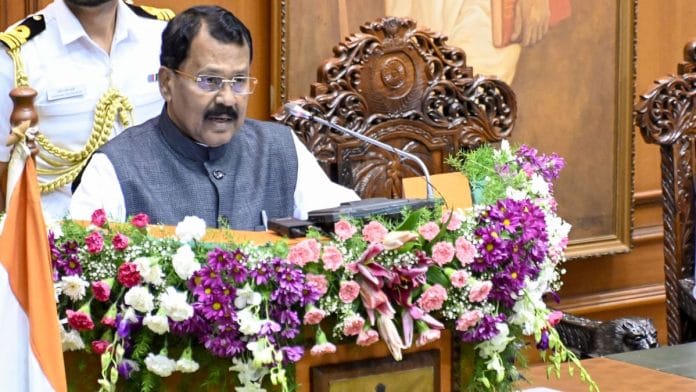Mumbai: The people of Goa have “as a whole” accepted a version of the Uniform Civil Code that the state has had for over a century, Goa Governor P.S. Sreedharan Pillai said Monday, at a time when the Narendra Modi-led Union government has been pushing for such a code across the country.
India’s smallest state has a Goa Civil Code, derived from the Portuguese Civil Code of 1867, which had been applied under Portuguese rule. Under the Goa Civil Code, all communities, including Hindus, Muslims and Christians, are governed by the same laws for marriage, divorce and succession, among other things.
In an interview with ThePrint, Governor Pillai, who has authored 237 books on various subjects, said he has studied the uniform civil code in Goa in detail and written a book on the subject, which he plans to publish after his tenure as governor ends.
“People here accepted it (uniform civil code) as a whole. There is a cordial relationship. There is no communal riot in Goa….In fact, I have prepared a book, but at this moment, a governor is not supposed to jump into disputes. That is why I am not publishing, but after my term’s over, I will,” he added.
Pillai further said, “Nearly 25-30 years ago, there had been an agitation started by a Muslim organisation, Personal Law Board or something like that, demanding personal law in Goa. That was defeated. The ladies and youngsters of the Muslim community went to the streets, protested against the demand, and the agitation was withdrawn.”
Pillai spoke extensively about his writings, his findings on the bonsai technique originating from ancient India, and how any regionalist movement in Goa would not find support among Goans.
Also read: Goa Congress calls for DGP’s ouster over alleged involvement in ‘illegal’ Assagao demolition
‘Bonsai art originally from India, travelled to China, Japan’
Pillai, who started his political career as a member of the Akhil Bharatiya Vidyarthi Parishad (ABVP), said he has been in the discipline of writing since his days in student politics.
Before being appointed to the Goa Raj Bhavan, Pillai was governor of Mizoram for 21 months. He wrote 38 books in that period by making use of the time he got during the Covid-19 pandemic, Pillai said.
Pillai became the governor of Goa in July 2021. Since then, Pillai said, he has visited all of Goa’s 500-odd villages to understand the issues people face and learn more about the state.
“Through this process, I got so many new ideas about temples, churches, trees,” Pillai said. The governor, so far, has written multiple books on Goa such as The Heritage Trees of Goa, and The Islands of Goa and is now writing a book on the state’s hills.
During one of his village visits, Pillai said, he came across the concept of ‘Vaman Vrusksha Kala’, which, he said, is the art of creating miniature trees or bonsai.
“When I passed through a village, a Sanskrit scholar told me that we don’t care about our initiatives from ancient times. We depend on other countries. They (foreigners) make use of it (ancient Indian knowledge), and he cited the bonsai technique,” Pillai said, adding that he studied more about it and found references to ‘Vaman Vruksha Kala’ in Ramayana in Kishkindha, the kingdom of monkeys.
“People, throughout the world, of course, believe bonsai originated in Japan. But, when I researched, I realised it had been there in Japan for only 1,000 years. In China, they have had this system for more than 2,000 years. Before that, it was in India,” Pillai said.
“In certain articles and writings, I found that our Buddhist monks, spreading Buddhism in China and Japan, carried it. Through them, it reached there. That is my theory,” he added.
Vaman Vruksha Kala was Pillai’s 200th book, launched in November 2023 by Vice President Jagdeep Dhankhar.
Based on the bonsai technique, the governor opened a garden in Goa’s Raj Bhavan with 71 plants on Prime Minister Narendra Modi’s 71st birthday. Now, he said, the garden has more than 1,000 plants.
Also read: Goa’s resentment toward outsiders and settlers is rising. Calangute tourist tax is a sign
‘Goa for Goans only will find no support in the state’
Goa has been seeing scattered incidents arising from resentment within the local population against tourists and settlers on allegations of the erosion of Goan culture and the increasing dominance of “outsiders” in the state.
The sentiment has given rise to parties such as the Revolutionary Goans, who clinched one assembly seat and nearly 10 percent of the state’s total vote share in the 2022 state polls.
Governor Pillai, however, said the phenomenon is no different from what happened in cities such as Mumbai and that a ‘Goa for Goans only’ slogan will find no support in the state.
“That trend is everywhere. For example, once upon a time, in my younger days, what was the movement in Mumbai? South Indian people, and all that. Now, that particular political party (has) so many leaders from Kerala. Shiv Sena has a Kerala unit, as well,” he said.
Pillai was referring to the roots of the undivided Shiv Sena, formed in 1966 on a nativist, ‘sons of the soil’ agenda, vociferously protesting against Indians coming to Mumbai from the southern parts, supposedly taking away jobs from residents.
“Our country is not a self-sufficient country. So many problems are there….due to political reasons, some regional reasons, some incidents may be there. But, I am sure that Goan people are patriotic people, they will never wholeheartedly support this,” he said.
Governor Pillai’s next project is to publish an updated version of his book, Dark Days of Democracy, which details the Emergency era. He plans to publish the updated version to mark the 50th year of Emergency next year.
(Edited by Madhurita Goswami)
Also read: Changing demographics, redefined Hindutva — the Sena-Muslim dynamic, from Bal Thackeray to Uddhav






